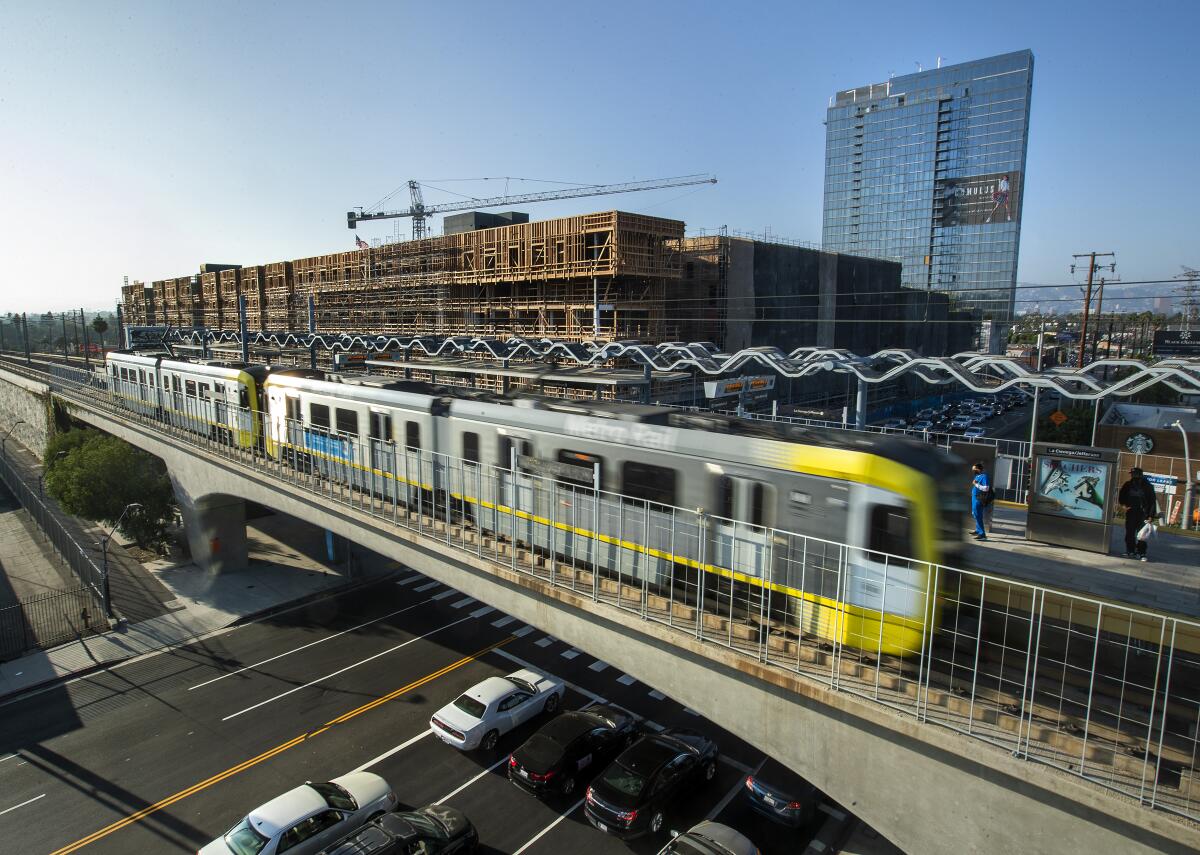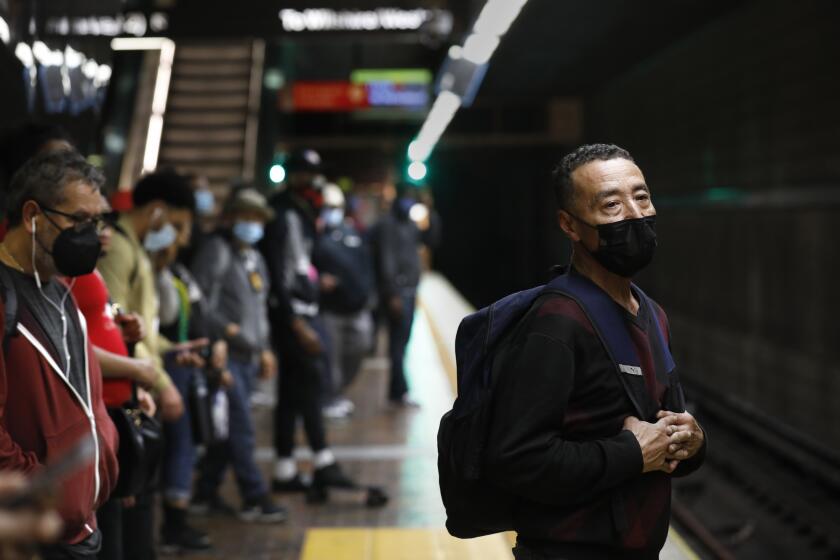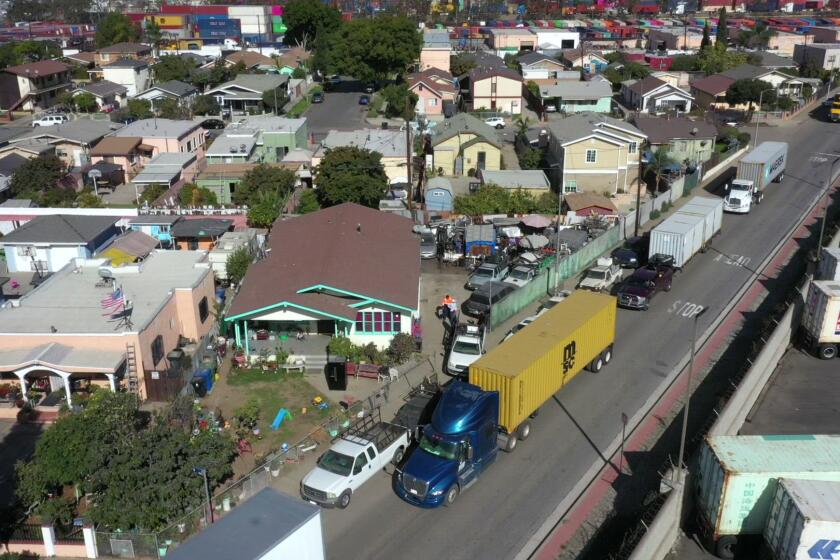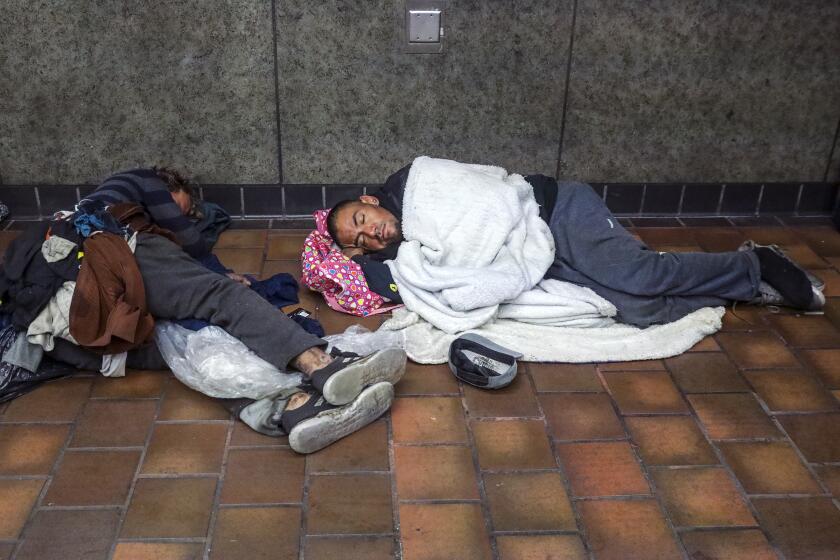South L.A. residents can get $150 a month in transit funds. What you need to know

- Share via
In a city as car-dependent as Los Angeles, people who can’t drive or can’t afford a vehicle of their own are at a huge disadvantage. Seleta Reynolds, general manager of the Los Angeles Department of Transportation, puts it this way: “Right now in Los Angeles, you can get to about 12 times as many jobs in an hour by car as you can in an hour by transit.”
Today, LADOT is formally launching a pilot program that aims to narrow that gap in South L.A. — not by putting more cars on the street, but by offering residents more aid and ways to get around town. The agency’s Sustainable Transportation Equity Project aims to make mass transit more affordable and accessible, increase the use of electric vehicles and cars, and promote EV-related jobs.
Reflecting a core environmental purpose of the project, most of the funding comes from the California Air Resources Board. The pilot also embraces an approach Reynolds calls “universal basic mobility” — the idea that every resident should have the resources to meet their basic transportation needs.
A key component of the project is a “mobility wallet” from LADOT and Metro that will be available to 2,000 residents in the project area, who will receive $150 in monthly aid for one year for public bus and train fares, on-demand shuttles, and scooter, bike and electric vehicle rentals. Loaded onto a Transit Access Pass card, the money will pay for rides on any transit line that’s part of the TAP system, Reynolds said, as well as for rentals from the BlueLA electric-car-sharing program and Metro Bike Share.
The wallet will be offered to community members who face mobility challenges, “including students, senior citizens, low-income residents and people with differing abilities,” the project’s website says. But the precise eligibility requirements for the wallet are still being worked out by LADOT, in consultation with a local advisory committee and the agency’s research partners at UC Davis, said Colin Sweeney, a spokesman for LADOT.
The monthly grants are expected to begin in the first three months of 2023, he said. If you sign up on the project’s website, he added, the agency will let you know when the wallet and other services (which have different timelines) become available.
Gasoline prices have reached record highs in Los Angeles, but convincing tens of thousands of Angelenos to leave their gas guzzlers at home is still a hard sell for many.
Other parts of the pilot include:
- More clean transportation options. The LA CleanTech Incubator is putting together an electric-bike library that will make e-bikes available for free or at low cost for extended periods of time. LADOT will try out an on-demand electric shuttle service to fill the gaps between its DASH bus routes. And the BlueLA program will make at least 50 more EVs available for rent by members in the project area.
- A network of public EV charging stations. Green Lots will install 21 chargers at five public libraries and 30 EV chargers on light poles maintained by the Bureau of Street Lighting. Other chargers will be added by EVGo and BlueLA.
- More pedestrian- and bike-friendly streets. The project envisions a variety of efforts to make streets more inviting to people on foot and on bicycle. Among them are enhancements along the coming light rail line connecting Exposition Boulevard and LAX.
- Training for EV-related jobs. The LA CleanTech Incubator and Los Angeles Trade Technical College will offer workforce training to community members seeking work as EV technicians. According to the LADOT, “participants will receive training in technical areas and interpersonal skills, and industry-recognized certifications to succeed in the green economy.”
The Air Resources Board provided $13.8 million for the project as part of its efforts to promote cleaner transportation in areas with a history of disinvestment in transportation, Sweeney said. That disinvestment has yielded bitter fruit, in the form of lower air quality, a higher concentration of fatal collisions and a lack of access to basic services and employment opportunities, he said.
“Transportation tends to be the reason why people are not living lives that they want,” Reynolds said. “They can’t get reliable and affordable access to get to the doctor’s office, or they don’t feel comfortable letting their kids walk down the street to the park without having parental supervision because they’re worried about cars and safety. Or they can’t get to their jobs on time consistently because they don’t have access to credit and they can’t afford a car.”
“I’m trying to level the playing field between me and somebody who lives in a certain neighborhood or is at an income level, but they have significantly fewer choices for how to get around,” Reynolds added. “How do we knit all this stuff together? And how do we talk about transportation in a different way so that we’re not just talking about getting from A to B, but we’re actually talking about the value that it adds to people’s lives — the jobs they can get to, the education they can reach, the things they can do for their families, the the recreation that they can get to — that, you know, makes life worth living.”
The city of L.A. added $4 million to the board’s contribution, giving the project a budget of nearly $18 million.
Residents of Drumm Avenue in Wilmington say truck traffic from the Port of Los Angeles makes them miserable.
Universal basic mobility programs are rare. A similar effort was launched in Portland in 2019, when the city gave residents of affordable housing developments access to free transportation options like transit passes, bike or scooter share memberships, and rideshare and car-share credits.
One 2021 study found that the program encouraged people to use transportation options they had never tried before, such as ride-hailing services, shared bikes and e-scooters. The program ultimately broadened where and how participants could travel, allowing them to make more trips, and to get to places that were once out of reach.
Oscar Zarate, an organizer with Strategic Actions for a Just Economy, welcomed the new transportation resources, which he said can bring much needed relief for working class people in South L.A., especially as its neighborhoods are recovering economically from the effects of the pandemic. Nevertheless, Zarate said he worried that the new transportation resources may inadvertently fuel gentrification and displacement of the people the program is intended to help.
“Those transportation resources are amenities to developers, which justifies higher rents, which prices out lower-income individuals,” Zarate said.
He also warned that the potential success of this program may distract officials and policymakers from the bigger goal of many advocates: free public transportation. “What’s the greatest economic relief?” Zarate asked. “Completely eliminating a cost for people.”
Sweeney said the program launching Tuesday is, in essence, a “proof of concept” that funding these services “makes a difference in people’s lives.” So the test will be not just how much the services are used, but also how much they improve the environment, health and safety on the streets, he said.
The project area extends roughly from the 10 Freeway to Florence Avenue, and from South Alameda Street to Crenshaw Boulevard. More than 370,000 people live there, with 29% of the households having incomes below the poverty line. More than 6% of the households do not own a vehicle, and 21% walk, bike or take transit to work, according to LADOT.
Thousands of homeless people find refuge from the streets riding trains and buses, hindering Metro’s efforts to boost commuter ridership.
More to Read
Sign up for Essential California
The most important California stories and recommendations in your inbox every morning.
You may occasionally receive promotional content from the Los Angeles Times.



















